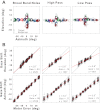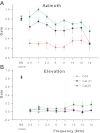The role of spectral composition of sounds on the localization of sound sources by cats
- PMID: 23274314
- PMCID: PMC3602938
- DOI: 10.1152/jn.00358.2012
The role of spectral composition of sounds on the localization of sound sources by cats
Abstract
Sound localization along the azimuthal dimension depends on interaural time and level disparities, whereas localization in elevation depends on broadband power spectra resulting from the filtering properties of the head and pinnae. We trained cats with their heads unrestrained, using operant conditioning to indicate the apparent locations of sounds via gaze shift. Targets consisted of broadband (BB), high-pass (HP), or low-pass (LP) noise, tones from 0.5 to 14 kHz, and 1/6 octave narrow-band (NB) noise with center frequencies ranging from 6 to 16 kHz. For each sound type, localization performance was summarized by the slope of the regression relating actual gaze shift to desired gaze shift. Overall localization accuracy for BB noise was comparable in azimuth and in elevation but was markedly better in azimuth than in elevation for sounds with limited spectra. Gaze shifts to targets in azimuth were most accurate to BB, less accurate for HP, LP, and NB sounds, and considerably less accurate for tones. In elevation, cats were most accurate in localizing BB, somewhat less accurate to HP, and less yet to LP noise (although still with slopes ∼0.60), but they localized NB noise much worse and were unable to localize tones. Deterioration of localization as bandwidth narrows is consistent with the hypothesis that spectral information is critical for sound localization in elevation. For NB noise or tones in elevation, unlike humans, most cats did not have unique responses at different frequencies, and some appeared to respond with a "default" location at all frequencies.
Figures







Similar articles
-
Effects of forward masking on sound localization in cats: basic findings with broadband maskers.J Neurophysiol. 2013 Oct;110(7):1600-10. doi: 10.1152/jn.00255.2013. Epub 2013 Jul 10. J Neurophysiol. 2013. PMID: 23843432 Free PMC article.
-
Influence of head position on the spatial representation of acoustic targets.J Neurophysiol. 1999 Jun;81(6):2720-36. doi: 10.1152/jn.1999.81.6.2720. J Neurophysiol. 1999. PMID: 10368392
-
Spectral cues explain illusory elevation effects with stereo sounds in cats.J Neurophysiol. 2003 Jul;90(1):525-30. doi: 10.1152/jn.00107.2003. J Neurophysiol. 2003. PMID: 12843315
-
Behavioral studies of sound localization in the cat.J Neurosci. 1998 Mar 15;18(6):2147-60. doi: 10.1523/JNEUROSCI.18-06-02147.1998. J Neurosci. 1998. PMID: 9482800 Free PMC article. Review.
-
[Sound localization cues of binaural hearing].Laryngorhinootologie. 2003 Apr;82(4):240-8. doi: 10.1055/s-2003-38932. Laryngorhinootologie. 2003. PMID: 12717598 Review. German.
Cited by
-
Crossmodal plasticity and hearing capabilities following blindness.Cell Tissue Res. 2015 Jul;361(1):295-300. doi: 10.1007/s00441-015-2175-y. Epub 2015 Apr 18. Cell Tissue Res. 2015. PMID: 25893928 Free PMC article. Review.
-
Localization of click trains and speech by cats: the negative level effect.J Assoc Res Otolaryngol. 2014 Oct;15(5):789-800. doi: 10.1007/s10162-014-0469-5. Epub 2014 Jun 19. J Assoc Res Otolaryngol. 2014. PMID: 24942705 Free PMC article.
-
Effects of forward masking on sound localization in cats: basic findings with broadband maskers.J Neurophysiol. 2013 Oct;110(7):1600-10. doi: 10.1152/jn.00255.2013. Epub 2013 Jul 10. J Neurophysiol. 2013. PMID: 23843432 Free PMC article.
-
The acoustical cues to sound location in the guinea pig (Cavia porcellus).Hear Res. 2014 Oct;316:1-15. doi: 10.1016/j.heares.2014.07.004. Epub 2014 Jul 19. Hear Res. 2014. PMID: 25051197 Free PMC article.
-
Gaze shifts to auditory and visual stimuli in cats.J Assoc Res Otolaryngol. 2013 Oct;14(5):731-55. doi: 10.1007/s10162-013-0401-4. Epub 2013 Jun 8. J Assoc Res Otolaryngol. 2013. PMID: 23749194 Free PMC article.
References
-
- Batteau DW. The role of the pinna in human localization. Proc R Soc Lond B Biol Sci 168: 158–180, 1967 - PubMed
-
- Beitel RE, Kaas JH. Effects of bilateral and unilateral ablation of auditory cortex in cats on the unconditioned head orienting response to acoustic stimuli. J Neurophysiol 70: 351–369, 1993 - PubMed
-
- Bernstein LR, Trahiotis C. Lateralization of sinusoidally amplitude-modulated tones: effects of spectral locus and temporal variation. J Acoust Soc Am 78: 514–523, 1985 - PubMed
-
- Blauert J. Sound localization in the median plane. Acustica 22: 205–213, 1969/1970
-
- Butler RA. An analysis of the monaural displacement of sound in space. Percept Psychophys 41: 1–7, 1987 - PubMed
Publication types
MeSH terms
Grants and funding
LinkOut - more resources
Full Text Sources
Other Literature Sources
Research Materials
Miscellaneous

